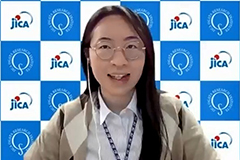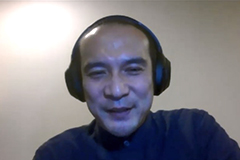The Face of Intercultural Cohesion Revealed by Asking Who the “Huaqiao” Are—Seminar Series on Migration History and Multicultural Understanding in Japan
2022.09.01
On March 10, 2022, the fifth lecture of the series “Migration History and Multicultural Understanding in Japan: Understanding ‘Others’ from Historical Perspectives” was jointly held by JICA Ogata Sadako Research Institute for Peace and Development (JICA Ogata Research Institute) and the Japanese Overseas Migration Museum at JICA Yokohama Center. This series of six lectures was held as part of JICA Ogata Research Institute’s project “Study on the International Migration and Networks of Japanese Descendants between Japan and Latin America.” For this fifth lecture, Nagamura Yukako, research fellow at JICA Ogata Research Institute, served as the moderator, and Yao Shohei, a research fellow of the Japan Society for the Promotion of Science, gave a talk under the theme “The World Seen from the Eyes of the ‘Huaqiao’.”

Nagamura Yukako, research fellow at JICA Ogata Research Institute
The terms “Huaqiao (‘Kakyo’ in Japanese)” and “Huaren (‘Kajin’ in Japanese)” refer to people of Chinese heritage around the world. While estimates put their population at 40–50 million, they are not properly understood. Yao started the lecture by clarifying that people tend to have the impression of Huaqiao having control over the global economy or being members of criminal organizations but such is not the reality. He emphasized that he wants to end such stereotyping and promote understanding that is more in line with reality.
Academically, a Huaqiao is defined as someone of Chinese heritage who lives outside of Greater China but does not have citizenship of his/her country of residence. This person would be identified as a Huaren if he/she has citizenship of his/her country of residence. These terms came into use since the mid-19th century but there were many people who already moved abroad from China before this. Yao gave an overview of the history of the Huaqiao. Back in the 15th century, when the Ming dynasty ruled China, it was the Huaqiao who started to move into Southeast Asia following Zheng He’s voyages and contributed to the development of trade networks there. When the Spanish advanced into the Philippines in the 16th century, again, it was the Huaqiao who took up the laborious work of carrying traded goods. He added that the Huaqiao settlement formed in Spanish-conquered Manila in 1582 is said to be the world’s oldest Chinatown. In the late modern period, following the First Opium War, people from China were introduced to many parts of the world as labor force essential for great Western powers to expand their colony operations. Historically, there was a time when millions of Chinese people migrated in essence like human trafficking, as cheap labor force in place of enslaved Black people was in need around the world, such as for tin mine development in the Malay Peninsula and the construction of the US Transcontinental Railroad. Huaqiao was a concept born at the time to manage these Chinese people living abroad. 60–70% of the Huaqiao scattered across the globe are said to be living in Southeast Asia today. This is because these people originally made up the labor force for mine development and at plantations in the 19th century. From the 20th century onward, some Huaqiao went on to start businesses like rubber-farm management. The Huaqiao were supporting colony operation at the front line in Southeast Asia.
Yao then introduced new research trends around the Huaqiao and Huaren, based on this history. The first one was the reconsideration of stereotyping minorities. When it comes to migrant workers, we tend to focus only on the “top players” who achieved great success after overcoming many hardships. Yet a new trend is gaining attention, saying that in addition to the handful outstanding ones, we should also look at the ordinary people who may not be top players but have been leading independent humble lives. The second one was studies that focus not only on how the majority and the minority can live in harmony but also on the different relationships between different minority groups. For example, many Native Americans as well as the Huaqiao and Huaren were involved in the construction of the US Transcontinental Railroad. Yao pointed out that they all shared the hardship of having to live somewhere far away from home and a sense of solidarity beyond ethnicity was born. He warned that traditional state-centric perspectives in American and Chinese history overlook such important points.

Yao Shohei, a research fellow of the Japan Society for the Promotion of Science
Upon bringing up the difficulty to categorize people of diverse backgrounds, Yao asked who the Huaqiao are again. Yao then said that his answer is that the name “Huaqiao” is nothing but a mark used to control people; it was a convenient way to label groups of people so that it would be easy to control them during colony operation and development. Because the definition is not strict, there is no way we can lump everyone together. However, precisely because there are so many inconsistencies, we can think about how to find connections that go beyond barriers between nationalities, regions and ethnicities and how to break down walls between those who govern and those who are governed, through the issue of the Huaqiao. The principle of intercultural cohesion is to equally realize lives with human dignity to all humans. Yao concluded by saying that he aspires to provide the knowledge needed to realize this through his studies.
In the Q&A session, questions came from the audience on various topics including the following: the origin of the stereotypical impression that the Huaqiao are skilled merchants; the reason Chinatowns exist all over the world; and whether it is really possible to go beyond nationalities, regions and ethnicities. This lecture gave the audience the opportunity to think about intercultural cohesion, the common theme throughout this lecture series.

事業事前評価表(地球規模課題対応国際科学技術協力(SATREPS)).国際協力機構 地球環境部 . 防災第一チーム. 1.案件名.国 名: フィリピン共和国.

事業事前評価表(地球規模課題対応国際科学技術協力(SATREPS)).国際協力機構 地球環境部 . 防災第一チーム. 1.案件名.国 名: フィリピン共和国.

事業事前評価表(地球規模課題対応国際科学技術協力(SATREPS)).国際協力機構 地球環境部 . 防災第一チーム. 1.案件名.国 名: フィリピン共和国.

事業事前評価表(地球規模課題対応国際科学技術協力(SATREPS)).国際協力機構 地球環境部 . 防災第一チーム. 1.案件名.国 名: フィリピン共和国.

事業事前評価表(地球規模課題対応国際科学技術協力(SATREPS)).国際協力機構 地球環境部 . 防災第一チーム. 1.案件名.国 名: フィリピン共和国.
scroll